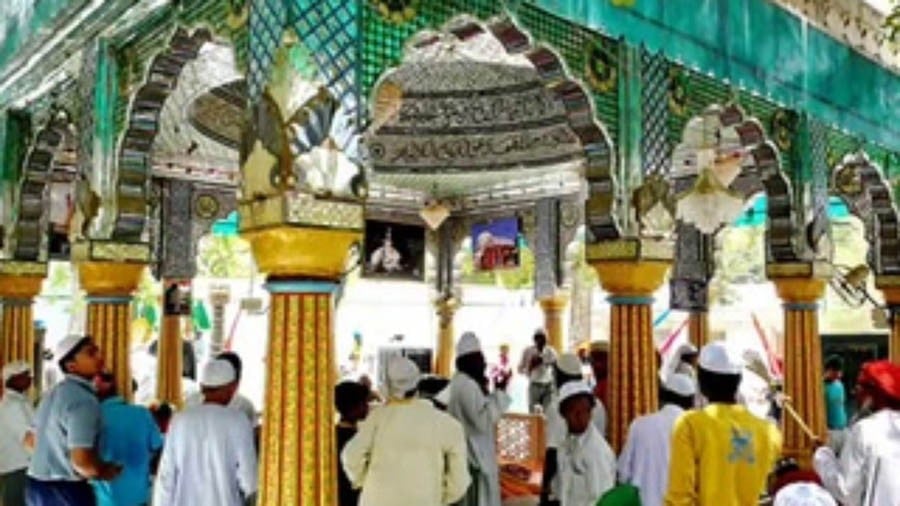
Barelvi evolution over the years

Picking up from last week’s column, I will assert that one of the many influences that modernity wrought on the Sufi ethos was the primacy accorded to the ‘text’. If that assertion is stretched a bit further, the conclusion that one may draw is that the interaction of Sufism with modernity culminated into the emergence of Barelvi creed. Chishtiyya and Qadiriyya Sufi Orders seemed to have subsumed into the Barelvi creed.
Ahmad Raza Khan from Bareilly (1856-1921), adherent of the Qadiriyya Order, laid the foundation of the Ahl-e Sunnat movement (I will use that terminology interchangeably with Barelvis). Strangely enough, in the objective situation obtaining in the second half of the 19th century, British colonialism had drawn various tools of rationality to the centre stage of the prevailing religious discourse. However, the intercessionary ritual practices remained the defining feature of the Ahl-e Sunnat movement.
For its opponents, usually representing the denominations like Deobandis and Ahl-e Hadith, shrine-centred devotion, demonstrated by Barelvi Sunnis, was in stark repudiation to its claim of being ‘reformist’, therefore rendering it ‘backward’, and ‘ignorant’. For Sunni (read Barelvi) luminaries, following the Prophet’s prescribed path (Sunna) with the help of saintly intermediaries, "provided a template for the behaviour in the modern world". According to Usha Sanyal, "In its self-consciousness the movement was based on a sense of individual responsibility, not on attachment to ancient custom (rawaj) as its detractors alleged".
Two points are to be teased out from the whole debate around Barelvi denomination and its evolution over the years: the validation of shrine-based practices through text (or interpretation of the text) and the question of it being historically embedded.
In many ways, the last quarter of the 19th century saw a few important changes coming into play in the Muslim world, and the subcontinent was no exception. Emergence of text-centred approach to religion was the most significant development in religious epistemology. The obvious outcome of this development was the renewed importance of exegesis (tafsir) of the Holy Quran and interpretation of Hadith according to the contemporary situation. The emphasis on Hadith in such seminaries like Dar ul Ulum Deoband enhanced the importance of ‘text’ even further. The ‘text’ came to be the standard bearer for ascertaining authenticity of any ritual or religious practice(s) prevalent in the contemporary era.
Thus shrine-centred practices became the subject of interrogation. Such practices not only connected Islam with the local cultural ethos underscoring ‘unity in diversity’ but they also made shrine a site for socio-religious inclusion, in which plurality could become possible. However, in the changed scenario, in the wake of colonial modernity and the advent of pan-Islamism (which too resulted from the phenomenon of modernity), the validity of ‘Sufi and Shrine’ became questionable. The specificity of Ahmad Raza Khan’s reformist zeal as opposed to that of Rashid Ahmad Gangohi or Muhammad Qasim Nanautawi is the former’s unflinching support to the time-honoured practice(s), performed at the shrine; instead of castigating them, he tried to bring them legitimacy through ‘text’. That was the reason that Ahmad Raza Khan remained in constant touch with the religious scholars in the Hijaz.
Read also: Sufis and the separatist identity
In simpler terms, in Ahmad Raza’s endeavours, we see Islam entwined with the local cultural moorings evolving through the historical process. What Ahmad Raza failed to guard against was the exclusion and takfir. In his famous fatwa Husam al-Haramain ala Manhar al-Kufr wa’l Main (The Sword of the Haramain at the Throat of Kufr and Falsehood), which was written in 1902 but became public in 1906, Ahmed Raza denounced several individuals in the early twentieth-century India. Mirza Ghulam Ahmad of Qadian was the first on Ahmad Raza’s lists of kafirs (infidels). He was followed by some eminent Ulema from Deoband denomination like Rashid Ahmad Gangohi, Muhammad Qasim Nanautawi, Ashraf Ali Thanvi and Khalil Ahmad Ambethwi whom he described as Wahabis. Among the twelver Shias and the organisation of the Ulema known as the Nadwat al-Ulama, he accused some specific people of kufr.
This is the situation right now when two Barelvi factions are trading fatwas, calling each other kafir. One shudders to think about the prevalent situation invested with the possible likelihood of sub-sectarian violence among the Sunnis.
Coming back to the historical analysis of Barelvis, in a bid to strike equilibrium between the ‘text’ and shrine-centric practices, Barelvi version of Islam appeared to have severed its link with the historical continuum. The practice of seeking authenticity of the rituals and religious practices from the ulema of Arabia was the principal cause of that continuum having been snapped. As a consequence, Barelvi denomination got stuck in ambivalence with a culture entwined with religion on one hand and spawning puritanical tendencies punctuated with the primacy of text on the other.
These trends have riddled the Barelvi sect with contradictions. Thus, its constituency is facing steady erosion.
Another important aspect is about the role of Ahl-e Sunnat wal Jamaat movement under the British, which was conciliatory towards the later. In the Khilafat Movement (1919-22), members of the ulema, influenced by Jamaluddin Afghani’s pan-Islamic message, forged an alliance with the Indian National Congress. M.K. Gandhi, top leader of Indian National Congress, lent support to the ulema in their demand for British recognition of the Turkish Sultan as Caliph. Ulema in turn supported the Indian nationalist struggle against the British rule. These decisions were made after threadbare debate in the meetings of Jamiyyat al-Ulama-e Hind, the religio-political party comprising Deobandi clerics.
Ahmad Raza Khan who, by that time, was a well-established leader of Ahl-e Sunnat movement, balked at supporting the Khilafat Movement or the pan-Islamic idea. Ahmad Raza was anti-Hindu which was one of the main reasons that Barelvis threw in their lot with the All Indian Muslim League. The role of Barelwi organisation(s) and various Mashaikhs like Pir of Golra Sharif or Jama’at Ali Shah in the Pakistan is well-documented, which also will be the theme of my next column.
(to be continued)